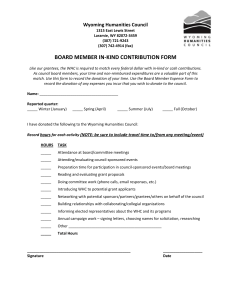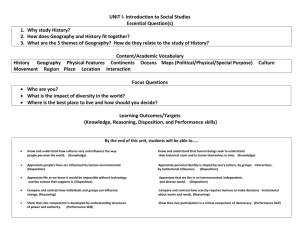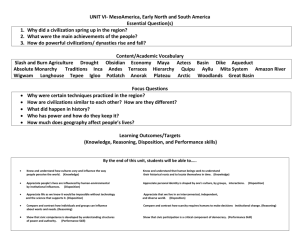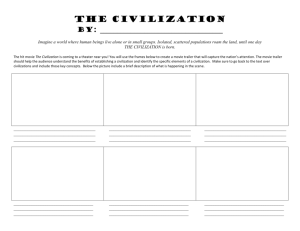UNIT II- The Beginnings of Civilization Essential Question(s)
advertisement
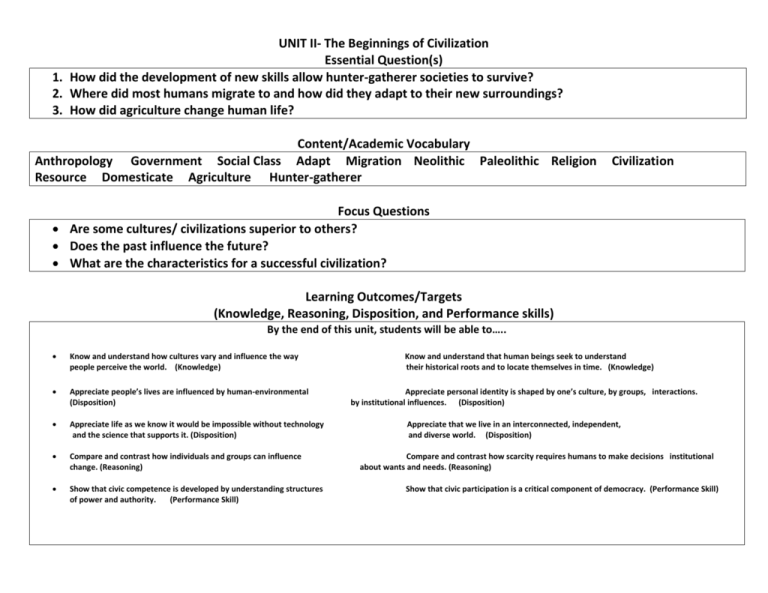
UNIT II- The Beginnings of Civilization Essential Question(s) 1. How did the development of new skills allow hunter-gatherer societies to survive? 2. Where did most humans migrate to and how did they adapt to their new surroundings? 3. How did agriculture change human life? Content/Academic Vocabulary Anthropology Government Social Class Adapt Migration Neolithic Paleolithic Religion Resource Domesticate Agriculture Hunter-gatherer Civilization Focus Questions Are some cultures/ civilizations superior to others? Does the past influence the future? What are the characteristics for a successful civilization? Learning Outcomes/Targets (Knowledge, Reasoning, Disposition, and Performance skills) By the end of this unit, students will be able to….. Know and understand how cultures vary and influence the way people perceive the world. (Knowledge) Appreciate people’s lives are influenced by human-environmental (Disposition) Appreciate life as we know it would be impossible without technology and the science that supports it. (Disposition) Compare and contrast how individuals and groups can influence change. (Reasoning) Show that civic competence is developed by understanding structures of power and authority. (Performance Skill) Know and understand that human beings seek to understand their historical roots and to locate themselves in time. (Knowledge) Appreciate personal identity is shaped by one’s culture, by groups, interactions. by institutional influences. (Disposition) Appreciate that we live in an interconnected, independent, and diverse world. (Disposition) Compare and contrast how scarcity requires humans to make decisions institutional about wants and needs. (Reasoning) Show that civic participation is a critical component of democracy. (Performance Skill) Idaho State Standards for Unit II Goal 1.6: Explain the rise of human civilization. Objective(s): By the end of World History and Civilization, the student will be able to: 6-9.WHC.1.6.1 6-9.WHC.1.6.2 6-9.WHC.1.6.3 Describe types of evidence used by anthropologists, archaeologists, and other scholars to reconstruct early human and cultural development. Describe the characteristics of early hunter-gatherer communities. Analyze the characteristics of early civilizations. Goal 1.7: Trace how natural resources and technological advances have shaped human civilization. Objective(s): By the end of World History and Civilization, the student will be able to: 6-9.WHC.1.7.1 Explain how man adapted the environment for civilization to develop. (462.04a) Goal 1.8: Build an understanding of the cultural and social development of human civilization. Objective(s): By the end of World History and Civilization, the student will be able to: 6-9.WHC.1.8.1 6-9.WHC.1.8.2 6-9.WHC.1.8.3 Find examples of how writing, art, architecture, mathematics, and science have evolved in western civilization over time. (462.05b) Identify the origins and characteristics of different social classes. Describe how the structure of family changes in relation to socioeconomic conditions. Goal 1.9: Identify the role of religion in the development of human civilization. Objective(s): By the end of World History and Civilization, the student will be able to: 6-9.WHC.1.9.1 6-9.WHC.1.9.2 6-9.WHC.1.9.3 6-9.WHC.1.9.4 Explain the relationship between religion and the peoples understanding of the natural world. (462.07c) Explain how religion shaped the development of western civilization. (462.07a) Discuss how religion influenced social behavior and created social order. (462.07b) Describe why different religious beliefs were sources of conflict. Goal 2.3: Trace the migration and settlement of human populations on the earth’s surface. Objective(s): By the end of World History and Civilization, the student will be able to: 6-9.WHC.2.3.1 6-9.WHC.2.3.2 6-9.WHC.2.3.3 6-9.WHC.2.3.4 Identify main reasons for major migrations of people. (463.03a) Explain how climate affects human migration and settlement. (463.03b) Describe how physical features such as mountain ranges, fertile plains, and rivers led to the development of cultural regions. (463.03c) Explain how transportation routes stimulate growth of cities and the exchange of goods, knowledge, and technology. (463.03d) Goal 3.1: Explain basic economic concepts. Objective(s): By the end of World History and Civilization, the student will be able to: 6-9.WHC.3.1.1 6-9.WHC.3.1.2 6-9.WHC.3.1.3 6-9.WHC.3.1.4 Explain how historically people have relied on their natural resources to meet their needs. (465.01b) List examples that show how economic opportunity and a higher standard of living are important factors in the migration of people. (465.01c) Analyze the role of money as a means of exchange. (465.02a) Describe alternative means of exchange. (465.02b)
